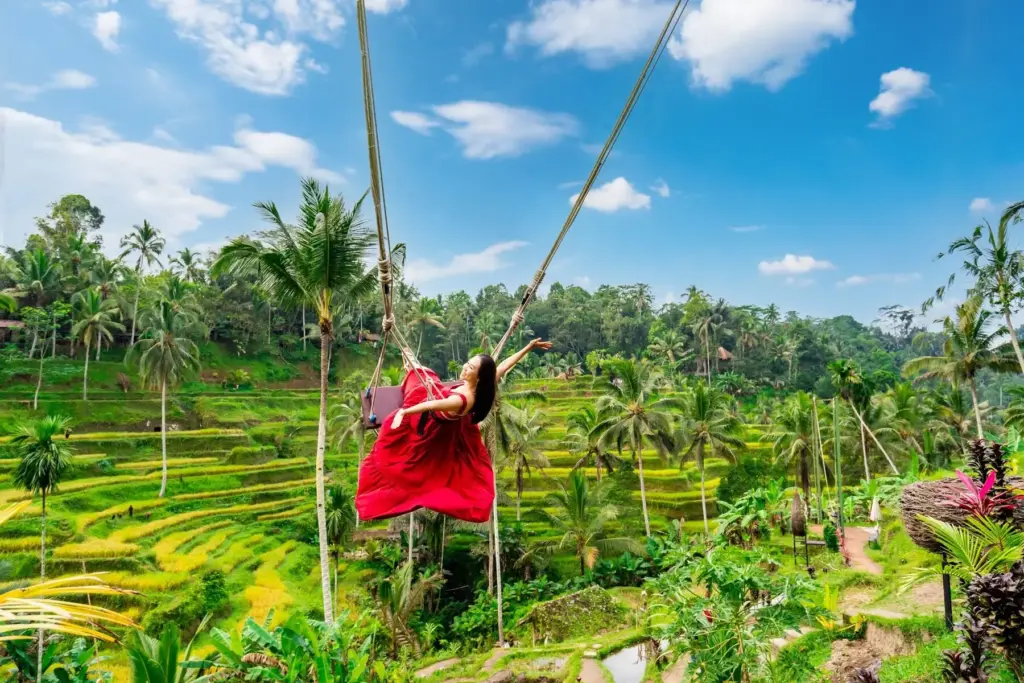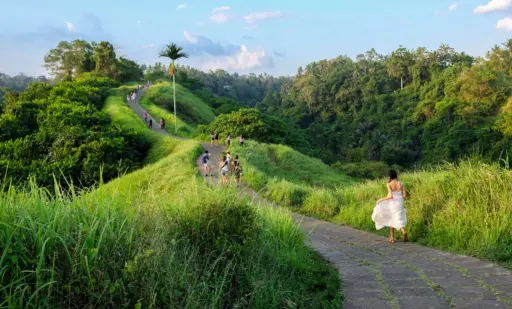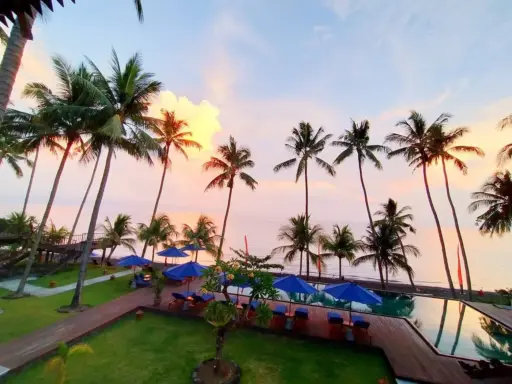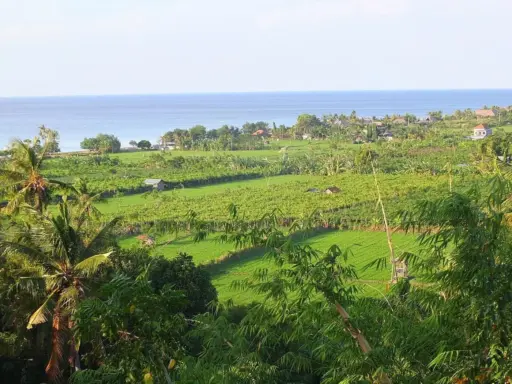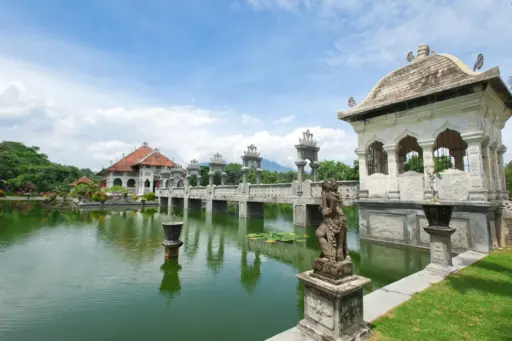Bali’s rice terraces are living landscapes of beauty, tradition, and spiritual harmony across valleys and hills.
Bali’s rice terraces are more than just a pretty view – they are the heart of the island’s rural life, shaped by centuries of tradition and community cooperation. These stepped green fields are part of an ancient irrigation system known as subak, which has been guiding water from Bali’s mountains to its paddies since the 9th century. While many visitors are drawn to Bali’s beaches and temples, a walk through these terraced landscapes offers something different: quiet, rhythm, and a deep connection to the land.
Jatiluwih: Bali’s UNESCO World Heritage Gem
Among the island’s many rice terraces, two stand out for their beauty and cultural significance – Jatiluwih and Tegallalang.
Jatiluwih, located in Tabanan Regency about two hours northwest of Ubud, is the largest and most impressive rice terrace system in Bali. The name literally means “truly beautiful” and it is easy to see why. Spread out across the lower slopes of Mount Batukaru, Jatiluwih offers uninterrupted views of layered fields, framed by distant volcanoes and bordered by jungle. Unlike the smaller, more manicured terraces elsewhere, Jatiluwih feels vast and wild. It is a place where farming is still a way of life, not just a photo opportunity.
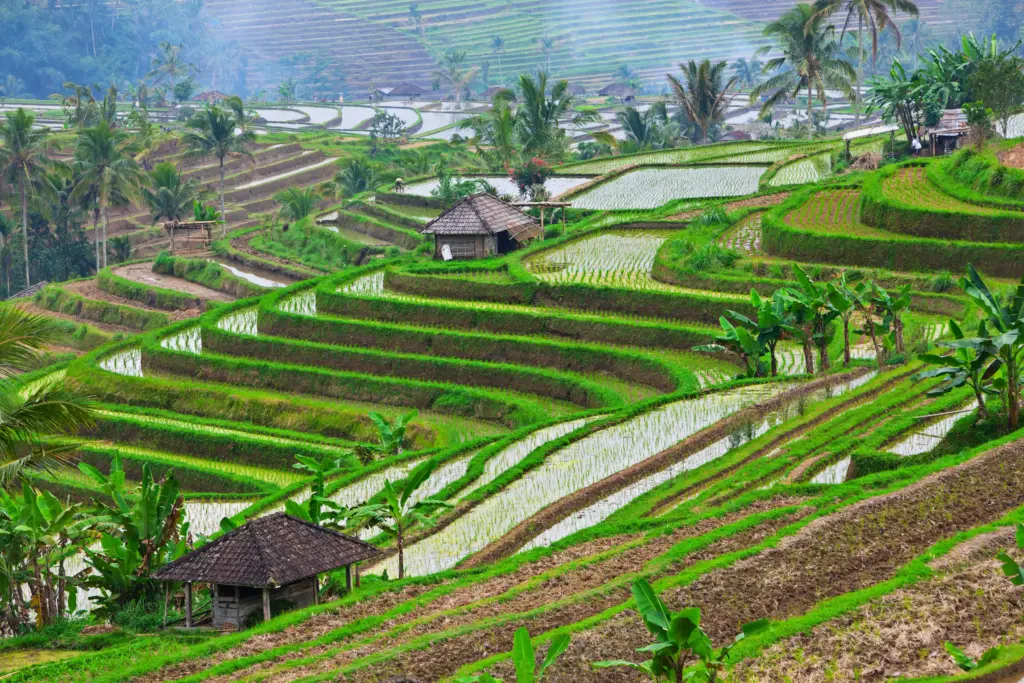
What sets Jatiluwih apart is its status as a UNESCO World Heritage Site, recognised for its preservation of the traditional subak system. Here, rice is grown organically, with water channels and footpaths weaving through the fields like veins in a leaf. Visitors can walk or cycle along well-marked trails, with short, medium and long routes that wind through the paddies and small villages. There are several cafes perched along the trails, offering fresh coconuts, coffee, and simple meals with unbeatable views. The air is cooler than the coast, and the pace is unhurried.
Jatiluwih is less crowded than many other sites, which makes it perfect for travellers who want a more immersive and quiet experience. You will often see farmers at work, cows grazing, and ceremonial offerings tucked into the corners of the fields. The area is also home to small temples and shrines, each tied to the agricultural cycles of planting, harvesting, and offering thanks. To walk through Jatiluwih is to witness not just scenery, but a living system of spiritual and ecological balance.
Tegallalang: Bali’s Most Photographed Rice Terraces
By contrast, Tegallalang Rice Terrace, located just 20 minutes north of Ubud, is Bali’s most photographed. Its symmetrical stair-step paddies climb the sides of a steep valley, creating a dramatic and instantly recognisable landscape. For many visitors, this is their first encounter with Bali’s rice terraces – and it delivers on visual impact. Early mornings are especially beautiful, when mist hangs low in the valley and the sunlight catches on the water-filled paddies.
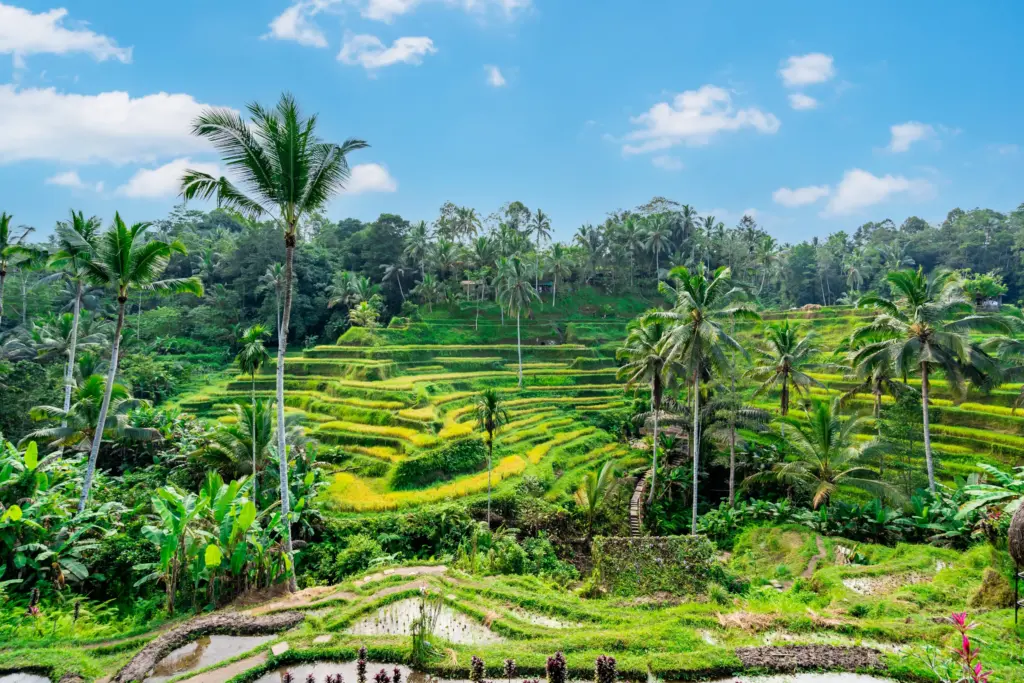
Tegallalang is more developed and busy than Jatiluwih, with roadside cafes, swings, and photo spots catering to day-trippers. There are several entrance points, and a small donation or entrance fee is usually collected to access the paths. While the main viewpoints near the road can feel crowded, walking deeper into the valley reveals quieter trails and smaller farms still in use by locals. Despite the tourism infrastructure, the beauty of the landscape remains powerful – especially if you allow yourself to go beyond the lens and linger a while.
Hidden Gems: Sidemen, Belimbing, and Munduk
Beyond these two, there are several other rice terrace areas in Bali worth exploring. In Sidemen, in East Bali, the terraces are smaller, more rustic, and less visited. Here, the land undulates gently across a valley with Mount Agung looming in the background. Farming is still entirely traditional, and the pace of life moves slowly. Walking through Sidemen’s paddies often means passing farmers in wide-brimmed hats, ducks waddling along muddy paths, and shrines wrapped in cloth tucked among the coconut trees. The trails are mostly unmarked but easy to follow, and local guides can offer insight into the crops, ceremonies, and community life.
In Belimbing, near Pupuan in West Bali, the rice terraces are broad and rolling, often overlooked by visitors. They offer a glimpse into a more remote and less developed part of the island. The views stretch for kilometres, with terraced hillsides folding into each other like waves. The region is also known for clove and coffee plantations, so it is possible to combine a rice terrace walk with a visit to a smallholding or local farm. The cooler climate and lack of tourist infrastructure give Belimbing a quiet, almost untouched feeling.
Another lesser-known gem is the area around Munduk, in North Bali. While better known for its waterfalls and mountain views, the region also has a scattering of steep, dramatic rice terraces, often framed by jungle and mist. Because Munduk is in the highlands, the landscape here feels more alpine than tropical, and the rice paddies are often mixed with other crops like coffee, cacao and spices. Walks here are best done with a guide, as the trails wind through remote valleys and village paths.
Subak: A Spiritual and Social System of Water
What makes all of Bali’s rice terraces remarkable is not just their appearance, but the system that sustains them. The subak irrigation system is more than an engineering solution – it is a social and spiritual institution. Each farmer in a village is part of a cooperative, sharing water and responsibilities. The water itself is considered sacred, flowing from mountain springs down through temples before entering the fields. Offerings are made at each stage, and ceremonies mark the agricultural calendar. This integration of nature, community, and belief is central to Balinese identity.
For travellers, walking through the rice terraces is one of the most peaceful and grounding experiences the island offers. Unlike scheduled tours or crowded attractions, the terraces invite you to slow down. There is no soundtrack, no crowd control, just the sound of birds, water trickling through bamboo channels, and the soft rustle of wind through young rice plants. It is a chance to see how the land is still worked by hand, how each stone wall and water channel reflects generations of knowledge.
Most rice terrace areas are accessible year-round, though the best times to visit are during the planting (January–February) or growing (March–May, September–October) seasons, when the fields are lush and green. Harvest time (June or November) is also beautiful in a different way, with golden stalks ready to be cut and gathered. After harvest, the fields may look muddy or dry for a few weeks, but the cycle quickly begins again.
Visitors should wear comfortable shoes, bring sun protection, and carry small notes for donations or purchases. Some trails cross private land, and locals may ask for a small contribution to maintain the paths. Most areas have small cafes or warungs nearby, and many guesthouses offer guided walks or maps for self-guided exploration.
In a place so often associated with dramatic coastlines and elaborate temples, Bali’s rice terraces offer something quieter and more elemental. They are a reminder of how beauty is cultivated – through patience, care, and cooperation with nature. Whether you find yourself standing at the edge of Tegallalang’s dramatic valley, wandering through Jatiluwih’s sweeping UNESCO fields, or following a footpath in Sidemen as the sun rises over Mount Agung, you will come away with more than just a photo. You will carry a piece of Bali’s soul – slow-growing, deeply rooted, and endlessly green.
